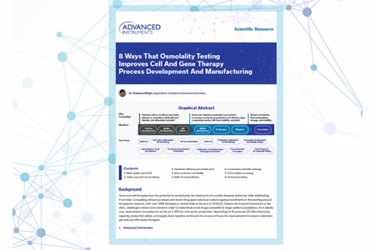8 Ways That Osmolality Testing Improves Cell And Gene Therapy Process Development And Manufacturing
By Dr. Kristeena Wright, Applications Scientist, Advanced Instruments

Gene and cell therapies have the potential to revolutionize the treatment of incurable diseases which are often debilitating, if not fatal. Compelling clinical successes and recent drug approvals have fueled ongoing investments in this exciting area of therapeutic research, with over 1000 therapies in clinical trials at the end of 2019 [1]. Despite the forward momentum in the clinic, challenges remain to be solved in order to make these novel drugs accessible to larger patient populations. As it stands now, downstream recoveries are as low as 5-30% for viral vector production, depending on the process [2]. Manufacturing capacity, production yields, and supply chain logistics continue to be an area of focus for improvements to ensure customers get safe and affordable therapies. The key to improvement and success is implementing high quality process design and process parameters to ensure robustness and reproducibility. What tools and checks can be implemented to ensure constant product and process control?
Osmolality is a measure of solute concentration and has long been considered a critical measurement in Biopharma [3, 4], describing how much of a solute is present in a given solution. From simple to complex solutions, osmolality represents a consistent and valuable concentration that is insensitive to temperature and pressure, which makes it a unique and beneficial parameter during bioprocessing. Osmolality directly affects the movement of solutes across a membrane [5], making it a necessity during cell processing and any subsequent testing of injectable products. However, there are numerous uses for testing throughout any bioproduction workflow, and cell and gene therapy development will certainly benefit from additional exciting applications. Eight emerging and novel uses for osmolality testing in advanced therapy production are outlined.
Get unlimited access to:
Enter your credentials below to log in. Not yet a member of Bioprocess Online? Subscribe today.
